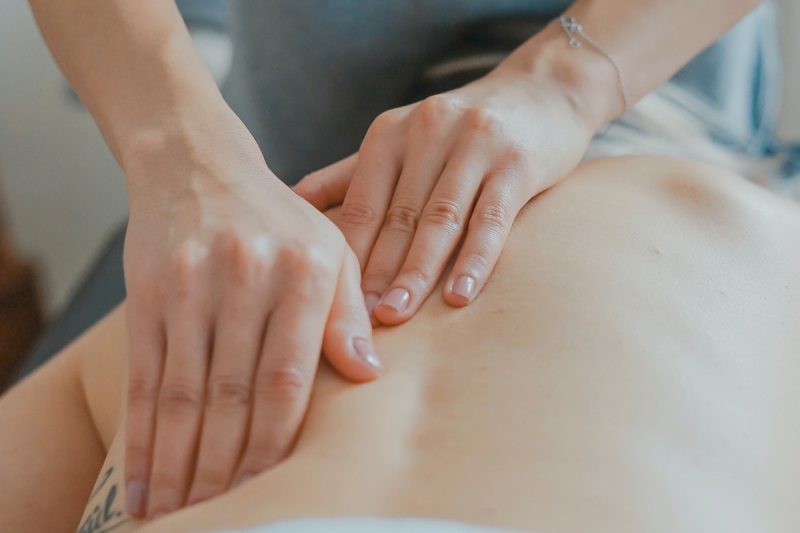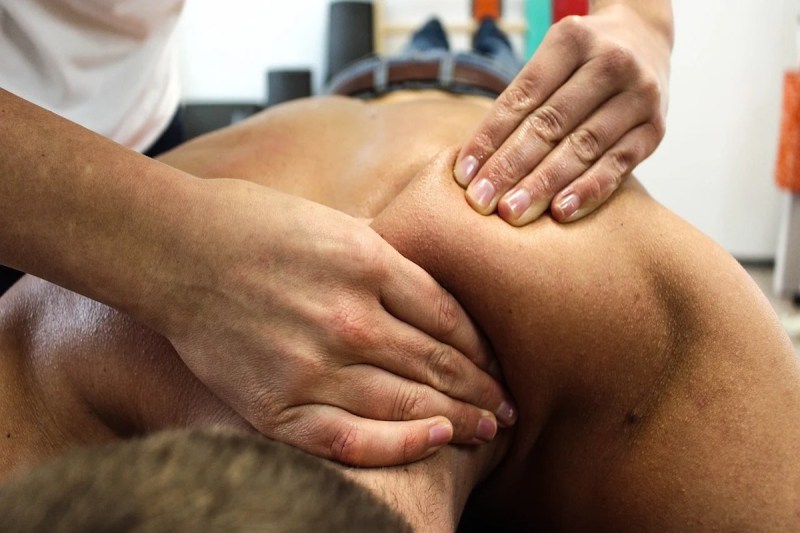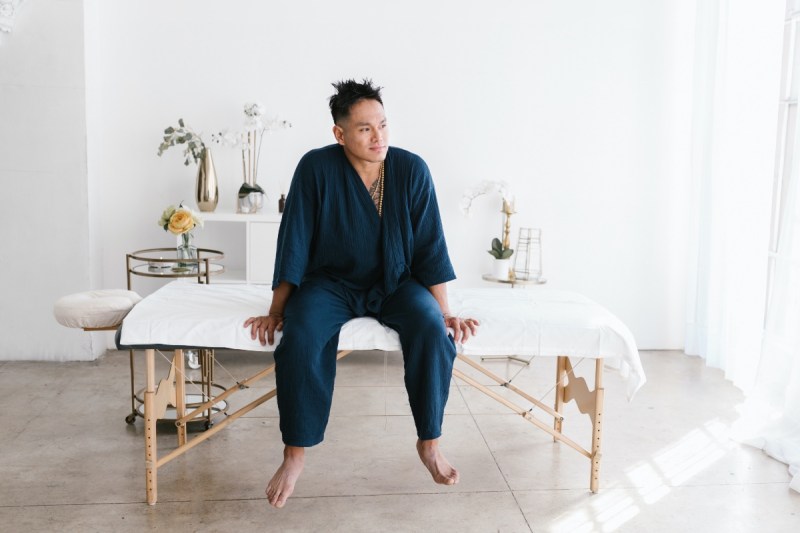
You’re training regularly, getting your workouts in, or maybe just starting a new regime, and recognize that even with regular stretching, certain muscles are still pretty stiff and uncomfortable. Ice packs, heating pads, and everything else you’ve tried aren’t working. It sounds like time to try a specific massage for men to get those knots undone.
No worries. We have everything you need to know about getting a basic massage. We spoke to licensed massage therapist Rich Kiamco, who trained at the Swedish Institute in New York, to get his expert opinion on the proper types of massage for a man, whether you need one due to muscle soreness from old age or your fitness journey.

Reasons you might need a massage
If you’re actively involved in any sports or workout, a good massage soothes and relaxes tight muscles and will ease soreness from injury, and even helps in recovery. Old injuries, new injuries, or just having slept on that pillow wrong and now you can’t turn your neck for five business days — could all be worked out with a massage.
You could even need a massage after a long flight. Do you fly a lot for work, or are you headed for a global vacation? “On an airplane, you’ve been sitting still and your body is atrophying. You’re immobilized, under pressure, and in a weird position, so your body is naturally stressed,” Kiamco said. “A good massage helps relieve that stress, stretches you out, and sends you back into the world refreshed. It’s generally a great way to relieve stress, relax, and remove toxins from your body. You’ll sleep better and think more clearly.”

4 main types of massages
If you’re not sure what kind you should get, it could be confusing picking through the various types of massage to find your fit. They’re all great, but each offers its own philosophy and specific benefits.
Thai massage
The Thai-style massage was developed by Buddhist monks thousands of years ago and has a bit more of a spiritual tradition associated with it. It involves more passive stretching and gentle pressure and is performed fully clothed on a futon. It may feel oddly intimate since the therapist will use their body weight to stretch certain muscles and move your body into various positions. It’s kind of like yoga, but you’re not doing the work.
Another kind of this style is the Shiatsu Massage. It has a similar discipline and shares certain techniques, but it has more to do with aligning the body’s qi than attending to the physical body itself.
Swedish massage
The Swedish massage is probably the most familiar to you because it follows more Western traditions of anatomy and physiology. This therapist will use broad general strokes, known as effleurage, to start, and then will move on to target specific problem areas.
Deep tissue massage
The deep tissue massage builds on the Swedish tradition, using pressure to release chronic muscle tension. It gets into deeper layers of muscle tissue and tendons. It’s said to reduce blood pressure and stress hormones and is specifically used to treat things like limited mobility and repetitive stress injuries like carpal tunnel syndrome, tennis elbow, or sciatica. The deep pressure breaks up knots of muscle and scar tissue to relieve pain and stiffness while increasing flexibility.
Sports massage
A sports massage is based on any or all these techniques and should be incorporated into your regimen if you are training for a specific event like a marathon, triathlon, Spartan Race, or a 5K. If you haven’t had a massage before (or haven’t had one in a while), don’t jump in too close to the event. Go every week or so early on in your training calendar, then around two days before the actual bout. Go again two or three days after you compete to work out the post-event soreness.
The practice helps prevent injuries due to overused and stressed muscles ahead of your competition, then reduces recovery time post-event. Be prepared with this one. Unlike a traditional massage, a sports massage therapist may give you homework and guidance on form correction like a coach.

Massage categories
Along with the types of massages, there are different categories of massages that those types fall under. These are the categories:
Relaxation and stress relief
- Swedish massage. Explained in detail above.
- Aromatherapy massage: This combines gentle Swedish massage with essential oils diffused in the air or lightly applied to your skin. The scents can enhance relaxation and offer additional therapeutic benefits.
- Hot stone massage: The massage therapist places warm, smooth stones on key points of your body to help massage your muscles. The heat helps penetrate tissues and provides deep relaxation.
Pain relief and muscle repair
- Deep tissue massage: Explained in detail above.
- Sports massage: Explained in detail above.
- Trigger point therapy: This massage targets specific pressure points in your muscles that can cause pain or discomfort. It can be quite effective for releasing tension and alleviating pain.
Other interesting options
- Thai massage: Explained in detail above.
- Reflexology: This focuses on massaging pressure points on your feet and hands that are believed to correspond to different organs and body systems. It can be helpful for promoting overall well-being and relaxation.

What to expect during a massage
- Be honest with your massage therapist
- Drink lots of fluids before and after
- Communication is key throughout
Need to know more about what happens during a massage? Kiamco recommends over-communicating with your therapist: “Let us know upfront about any medical issues you are experiencing. Do you have back pain or any injuries? Any skin conditions? In fact, if you have a rash of any sort, you should not get a message. Keep hydrated both before and after the session. This is all about your comfort, so, just like life, be clear and direct about what you expect. Do you want deeper or more gentle pressure?”
Depending on your comfort level, you could be naked, wear underwear, have on boxers, or even wear a swimsuit. “You’re here to take care of yourself and relax,” Kiamco explained. “Set clear boundaries for yourself and the therapist.”
Any private bits will be covered with a towel, sheet, or even a blanket to keep your body warm and blood circulating, so don’t be concerned with modesty. Unless you’re working with a trainee or a newbie, most massage therapists have seen it all and will not care about your appearance. You’ll then climb onto a massage table and lay on your stomach, with your head supported by a face rest to breathe comfortably. The therapist will then rub your skin and muscles with oil or cream.
“People have various fragrance sensitivities,” Kiamco pointed out. “A lot of my customers will ask me to let them smell the product I’m using first. They may choose to go with something unscented, or with a fragrance they like.”
He pointed out that there is such a thing as a dry massage, using no product at all. Once oiled up, your therapist will begin. Be sure to check in with your therapist about any discomfort during the session.

See a licensed professional
For safety’s sake, we recommend finding a licensed professional. That way you’re likely to avoid injury and to have the best experience possible. Check out the American Massage Therapy Association. Although the site is primarily for massage professionals to get together, there is a link to help find a massage therapist by name, keyword, or location.
Kiamco, for instance, attended the Swedish Institute in New York City and had to complete a certain number of hours before getting certified, based on the requirements of the State of New York, and has to take continuing education credits to maintain his license. You may also get a referral to somebody through a spa or gym.
This is not to say you might not get a decent rubdown by one of those people in the mall or an airport, but if you are getting a massage to address a specific concern, why risk it? For that same reason, you may see advertisements for “body work” or “foot massage,” terms often used by those who give massages, but are not licensed. Laws change from state to state, but in most cases, you can’t legally offer a massage without a license.

Massage etiquette
- Cleanliness is appreciated and expected.
- You don’t need your phone on during the session.
- Normal body noises are expected, but bigger issues need the bathroom.
- Please tip.
- Be early to fill out the paperwork.
We know you are ready to book that massage, but we couldn’t let you go without a bit of basic massage etiquette that everyone should know.
Start with a shower before you go, as the therapist will be rubbing their hands all over your body, so present a clean canvas. If you don’t want to touch a sweaty person straight from work or the gym, don’t do the same. With your phone, it’s not enough to turn the ringer off. If you have it set to vibrate, that could get distracting — and annoying — if it keeps going off in a quiet room. Shut the whole thing down.
We all do it. When you get relaxed on that table, you’re going to fart. Maybe some other noises will escape here and there. Unless it’s your massage therapist’s first day, they’ve heard it all. You don’t have to let it all out, but don’t freak out if something squeaks.
For the beginning and the end — make sure to get there early and make sure to tip. You’ll have to fill out paperwork when you get there, so don’t roll in at your appointment time and make everyone wait. And like with all services, please tip.
Massages aren’t just something to get your mother for her birthday. They are a great way to treat your body to much-deserved relaxation and recuperation. Follow the etiquette, find out what kind you want, and enjoy a perfect massage for men that will have you feeling like a younger, less painful you.



